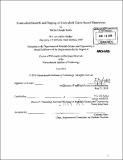| dc.contributor.advisor | Silvija Gradečak. | en_US |
| dc.contributor.author | Tambe, Michael Joseph | en_US |
| dc.contributor.other | Massachusetts Institute of Technology. Dept. of Materials Science and Engineering. | en_US |
| dc.date.accessioned | 2010-10-12T18:52:00Z | |
| dc.date.available | 2010-10-12T18:52:00Z | |
| dc.date.copyright | 2010 | en_US |
| dc.date.issued | 2010 | en_US |
| dc.identifier.uri | http://hdl.handle.net/1721.1/59237 | |
| dc.description | Thesis (Ph. D.)--Massachusetts Institute of Technology, Dept. of Materials Science and Engineering, 2010. | en_US |
| dc.description | Includes bibliographical references (p. 151-158). | en_US |
| dc.description.abstract | The use of compound semiconductor heterostructures to create electron confinement has enabled the highest frequency and lowest noise semiconductor electronics in existence. Modem technology uses two-dimensional electron gasses and there is considerable interest to explore one-dimensional electron confinement. This thesis develops the materials science toolkit needed to fabricate, characterize, and control the compositional, structural and electronic properties of core-shell GaAs/AlGaAs nanowires towards studying quasi-one-dimensional confinement and developing high mobility electronics First, nanowire growth kinetics were studied to optimize nanowire morphology. Variations in nanowire diameter were eliminated by understanding the role Ga adatom diffusion on sidewall deposition and vertical growth was enabled by understanding the importance of Ga and As mass-transport to nanowire nucleation. These results demonstrate that arrays of vertically-aligned GaAs nanowires can be produced. Then, the deposition of epitaxial AlGaAs shells on GaAs nanowires was demonstrated. By reducing the nanowire aerial density the stability of the nanowire geometry was maintained. A variety of analytical electron microscopy techniques confirmed the shell deposition to be uniform, epitaxial, defect-free, and nearly atomic sharp. These results demonstrate that core-shell nanowires possess a core-shell interface free of many of the imperfections that lithographically-defined nanowires possess. Finally, the adverse effect of the Au seed nanoparticle during n-type doping was identified and n-type doping was achieved via the removal of the Au nanoparticle prior to doping. A combination of energy dispersive X-ray spectroscopy, current-voltage, capacitance-voltage, and Kelvin probe force microscopy demonstrated that if the Au seed nanoparticle is present during the shell deposition, Au diffuses from the seed nanoparticle and creates a rectifying IV behavior. A process was presented to remove the Au nanoparticle prior to shell deposition and was shown to produce uniform n-type doping. The conductivity of GaAs/n-GaAs nanowires was calculated as a function of donor concentration and geometric factors taking into account the effects of Fermi level pinning. The control demonstrated over all of these parameters is sufficient enough for core-shell nanowires to be considered candidates for high mobility electronics. | en_US |
| dc.description.statementofresponsibility | by Michael Joseph Tambe. | en_US |
| dc.format.extent | 158 p. | en_US |
| dc.language.iso | eng | en_US |
| dc.publisher | Massachusetts Institute of Technology | en_US |
| dc.rights | M.I.T. theses are protected by
copyright. They may be viewed from this source for any purpose, but
reproduction or distribution in any format is prohibited without written
permission. See provided URL for inquiries about permission. | en_US |
| dc.rights.uri | http://dspace.mit.edu/handle/1721.1/7582 | en_US |
| dc.subject | Materials Science and Engineering. | en_US |
| dc.title | Controlled growth and doping of core-shell GaAs-based nanowires | en_US |
| dc.type | Thesis | en_US |
| dc.description.degree | Ph.D. | en_US |
| dc.contributor.department | Massachusetts Institute of Technology. Department of Materials Science and Engineering | |
| dc.identifier.oclc | 666494843 | en_US |
